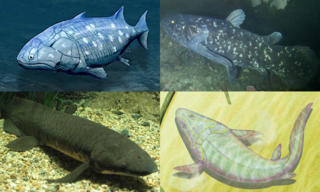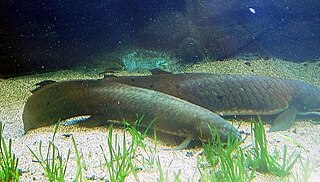Related Research Articles

Lungfish are freshwater rhipidistian fish belonging to the order Dipnoi. Lungfish are best known for retaining primitive characteristics within the Osteichthyes, including the ability to breathe air, and primitive structures within Sarcopterygii, including the presence of lobed fins with a well-developed internal skeleton. Lungfish represent the closest living relatives of the tetrapods.

Sarcopterygii —sometimes considered synonymous with Crossopterygii —is a clade of the bony fishes whose members are known as lobe-finned fishes. The group Tetrapoda, a superclass including amphibians, reptiles, and mammals, evolved from certain sarcopterygians; under a cladistic view, tetrapods are themselves considered a group within Sarcopterygii.

The Australian lungfish, also known as the Queensland lungfish, Burnett salmon and barramunda, is the only surviving member of the family Neoceratodontidae. It is one of only six extant lungfish species in the world. Endemic to Australia, the Neoceratodontidae are an ancient family belonging to the class Sarcopterygii, or lobe-finned fishes.

Lepidosirenidae is a family of lungfish containing the genera Lepidosiren and Protopterus. Both genera were formerly thought to represent the distinct families Lepidosirenidae and Protopteridae within the order Lepidosireniformes, but a 2017 study analyzing all post-Devonian lungfish taxa found them to be better classified as different genera in a single family.

Neoceratodus is a genus of lungfish in the family Neoceratodontidae. The extant Australian lungfish is the only surviving member of this genus, but it was formerly much more widespread, being distributed throughout Africa, Australia, and South America. Species were also much more diverse in body plan; for example, the Cretaceous species Neoceratodus africanus was a gigantic species that coexisted with Spinosaurus in what is now the Kem Kem Formation of Morocco. The earliest fossils from this genus are of Neoceratodus potkooroki from the mid Cretaceous (Albian-Cenomanian) Griman Creek Formation of Australia, remains from the Late Jurassic of Uruguay assigned to this genus probably do not belong to the genus.
Dipnorhynchus is an extinct genus of lungfish from the middle Devonian period of Australia and Europe.
Griphognathus ("hook-jaw") is an extinct genus of lungfish from the late Devonian period of Europe and Australia.

The Gnathorhizidae are an extinct family of lungfish that lived from the late Carboniferous until the middle Triassic. Gnathorhizid fossils have been found in North America, Madagascar, Australia, and possibly Eastern Europe and South Africa. They are characterized by high-ridged toothplates that form cutting blades and a reduction in cranial bones.

Wee Jasper is a village in the Goodradigbee valley at the western foot of the Brindabella Ranges, near Burrinjuck Dam in New South Wales, Australia in Yass Valley Shire. It is located about 90 km north-west of Canberra and 60 km south-west of Yass. At the 2016 census, Wee Jasper and the surrounding area had a population of 100.
Amadeodipterus is an extinct genus of lungfish which lived during the Devonian period. Fossils have been found in Central Australia.
Ichnomylax is an extinct genus of lungfish which lived during the Devonian period. Fossils have been found in Australia and Russia.
Soederberghia is a genus of prehistoric lungfish that lived during the late Devonian period.
Gogodipterus is an extinct genus of prehistoric lungfish in the family Chirodipteridae. It was discovered ar the Late Devonian Gogo Formation of Western Australia.
Mioceratodus is an extinct genus of lungfish in the family Neoceratodontidae, which also contains the extant Queensland lungfish. It is known only from Oligocene and Miocene-aged sediments in Australia, although phylogenetic evidence supports it having first diverged from its closest relative, Neoceratodus, during the Late Jurassic or Early Cretaceous period.
Rhinodipterus is an extinct genus of prehistoric dipnoan sarcopterygians or lobe-finned fish, that lived in the Devonian Period, between 416 and 359 million years ago. It is believed to have inhabited shallow, salt-water reefs, and is one of the earliest known examples of marine lungfish. Research based on an exceptionally well-preserved specimen from the Gogo Formation of Australia has shown that Rhinodipterus has cranial ribs attached to its braincase and was probably adapted for air-breathing to some degree as living lungfish are. This could be the only case known for a marine lungfish with air-breathing adaptations.
Paraceratodus is an extinct genus of prehistoric lungfish. Only one species, P. germaini, is known from the latest Permian or earliest Triassic period of Madagascar. Phylogenetic evidence supports it being the most basal member of the suborder Ceratodontoidei, which contains modern lungfish, and as with the rest of the order it likely diverged during the late Carboniferous.
Chirodipterus australis is an extinct species of lungfish which lived during the Devonian period. Fossils have been found in Australia.
Chirodipterus paddyensis is an extinct species of lungfish which lived during the Devonian period. Fossils have been found in Europe and Australia.
Griphognathus whitei is an extinct species of lungfish from the late Devonian period of Europe and Australia.

Neoceratodontidae is a family of lungfish containing the extant Australian lungfish and several extinct genera. It and Lepidosirenidae represent the only lungfish families still extant.
References
- ↑ Miles, R. S. (1977). "Dipnoan (lungfish) skulls and the relationships of the group: a study based on new species from the Devonian of Australia". Zoological Journal of the Linnean Society. 61 (1–3): 1–328. doi:10.1111/j.1096-3642.1977.tb01031.x. ISSN 0024-4082.